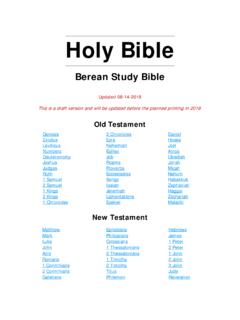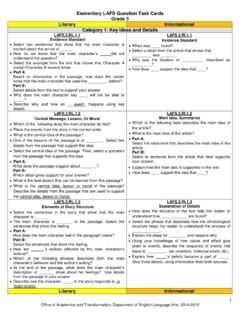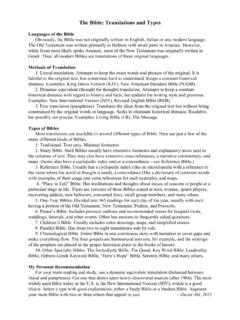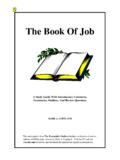Transcription of TRANSLATION, TYPES OF TRANSLATION
1 TRANSLATION , TRANSLATION , TYPES OF TRANSLATIONTYPES OF TRANSLATION TRANSLATION (or the practice of TRANSLATION ) is a set of actions performed by the translator while rendering the source (or original) text (ST) into another language. TRANSLATION is a means of interlingual communication. The translator makes possible an exchange of information between the users of different languages by producing in the target language (TL or the translating language) a text which has an identical communicative value with the source (or original) text (ST). This target text (TT, that is the TRANSLATION ) is not fully identical with ST as to its form or content due to the limitations imposed by the formal and semantic differences between the source language (SL) and TL.
2 Nevertheless the users of TT identify it, to all intents and purposes, with ST functionally, structurally and semantically. The functional identification is revealed in the fact that the users (or the TRANSLATION receptors TR) handle TT in such a way as if it were ST, a creation of the source text author. The structure of the TRANSLATION should follow that of the original text: there should be no change in the sequence of narration or in the arrangement of the segments of the text. The aim is maximum parallelism of structure which would make it possible to relate each segment of the TRANSLATION to the respective part of the original.
3 Of major importance is the semantic identification of the TRANSLATION with ST. It is presumed that the TRANSLATION has the same meaning as the original text. No exchange of information is possible if there is discrepancy between the transmitted and the received message. The presumption of semantic identity between ST and TT is based on the various degrees of equivalence of their meanings. The translator usually tries to produce in TL the closest possible equivalent to ST. The translating process includes two mental processes understanding and verbalization. First, the translator understands the contents of ST, that is, reduces the information it contains to his own mental program, and then he develops this program into TT.
4 The translating process has to be described in some TRANSLATION models. A model is a conventional representation of the translating process describing mental operations by which the source text or some part of it may be translated, irrespective of whether these operations are actually performed Навчальний пос бник з курсу Теор я та практика перекладу THE WORLD OF INTERPRETING AND TRANSLATING 7 by the translator. TRANSLATION models can be oriented either toward the situation reflected in the ST contents or toward the meaningful components of the ST contents. The existing models of the translating process are based on the situational (or referential) model, which is based on the identity of the situations described in the original text and in the TRANSLATION , and the semanticEtransformational model postulates the similarity of basic notions and nuclear structures in different languages.
5 These postulates are supposed to explain the dynamic aspects of TRANSLATION . In other words, it is presumed that the translator actually makes a mental travel from the original to some interlingual level of equivalence and then further on to the text of TRANSLATION . In the situational model this intermediate level is extralinguistic. It is the described reality, the facts of life that are represented by the verbal description. The process of translating presumably consists in the translator getting beyond the original text to the actual situation described in it. This is the first step of the process, the break through to the situation.
6 The second step is for the translator to describe this situation in the target language. Thus the process goes from the text in one language through the extralinguistic situation to the text in another language. The translator first understands what the original is about and then says the same things in TL. The translating process may be described as a series of transformations. The transformational model postulates that in any two languages there is a number of nuclear structures which are fully equivalent to each other. Each language has an area of equivalence in respect to the other language.
7 It is presumed that the translator does the translating in three transformational strokes. First the stage of analysis he transforms the original structures into the nuclear structures, he performs transformation within SL. Second the stage of TRANSLATION proper he replaces the SL nuclear structures with the equivalent nuclear structures in TL. And third the stage of synthesis he develops the latter into the terminal structures in the text of TRANSLATION . Thus if the English sentence It is very strange this domination of our intellect by our digestive organs is translated into Ukrainian as Дивно, якою м рою органи травлення волод ють нашим розумом we presume that the structures domination of our intellect and domination by our digestive organs were first reduced to the nuclear structures organs dominate and they dominate intellect , respectively.
8 Then they were replaced by the equivalent Ukrainian structures органи волод ють and вони волод ють розумом , after which the nuclear structures were transformed into the final Ukrainian variant. The theory of TRANSLATION provides the translator with the appropriate tools of analysis and synthesis, makes him aware of what he is to look for Кузенко Г.М. 8 in the original text, what type of information he must convey in TT and how he should act to achieve his goal. In the final analysis, however, his trade remains an art. Contemporary TRANSLATION activities of a translator are characterized by a great variety of TYPES , forms and levels of his responsibility.
9 The translator has to deal with works of the great authors of the past and of the leading authors of today, with intricacies of science fiction and the accepted stereotypes of detective stories; must be able to cope with the elegancy of expression of the best masters of literary style and with the tricks and formalistic experiments of modern avant gardists; has to preserve and fit into a different linguistic and social context a gamut of shades of meaning and stylistic nuances expressed in the original text by a great variety of language devices: neutral and emotional words, archaic words and new coinages, metaphors and similes, foreign borrowings, dialectal, jargon and slang expressions, stilted phrases and obscenities, proverbs and quotations, illiterate or inaccurate speech, and so on and so forth.
10 Has to tackle complicated specialized descriptions and reports on new discoveries in science or technology for which appropriate terms have not yet been invented. His duty is to translate diplomatic representations and policy statements, scientific dissertations and brilliant satires, maintenance instructions and after dinner speeches, etc. The original text may deal with any subject from general philosophical principles or postulates to minute technicalities in some obscure field of human endeavour. Translating a play the translator must bear in mind the requirements of theatrical presentation, and dubbing a film he must see to it that his TRANSLATION fits the movement of the speakers lips.






